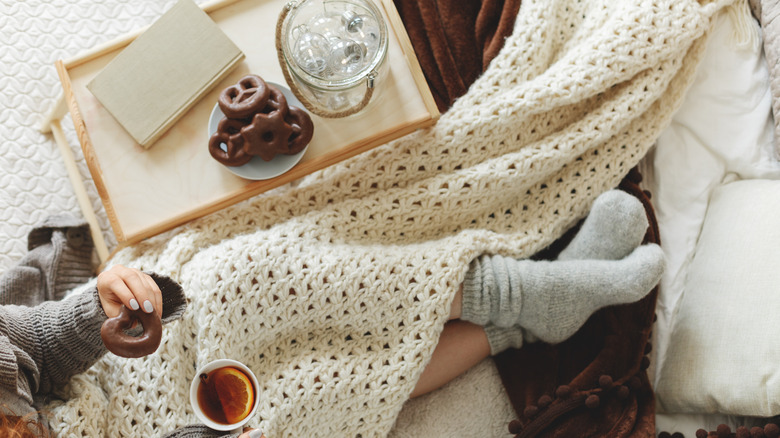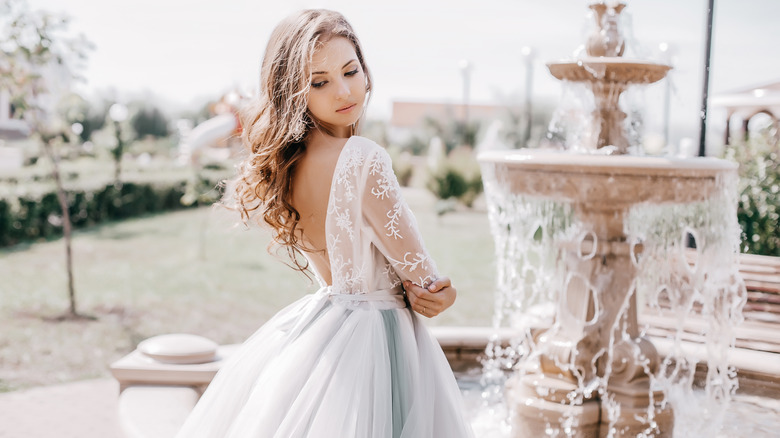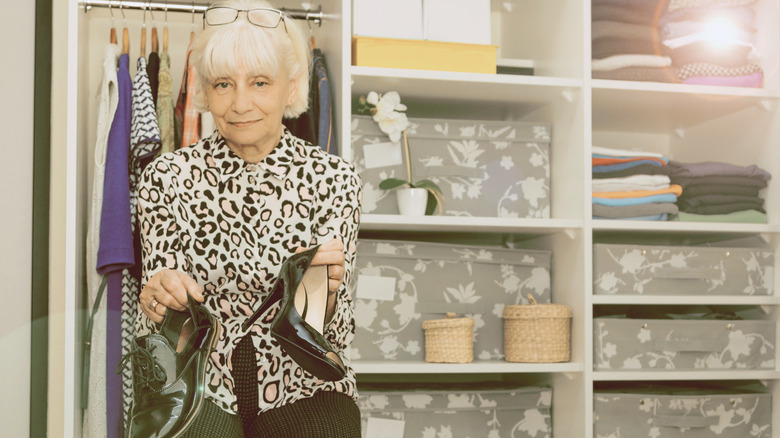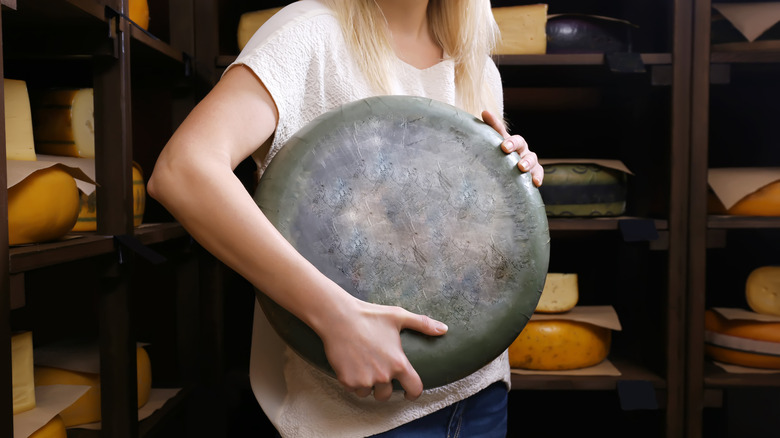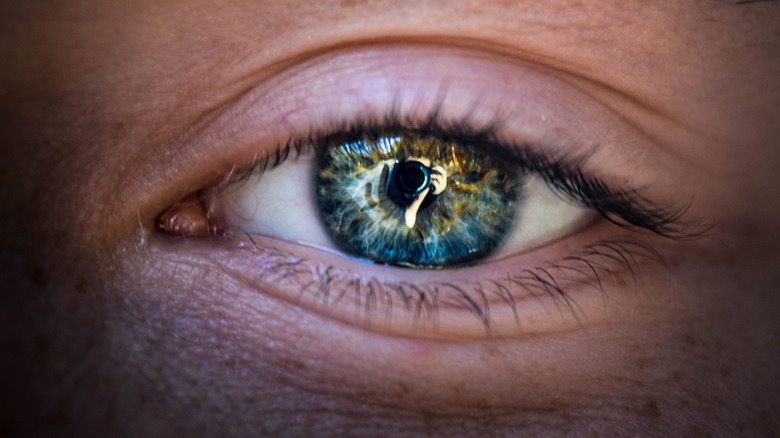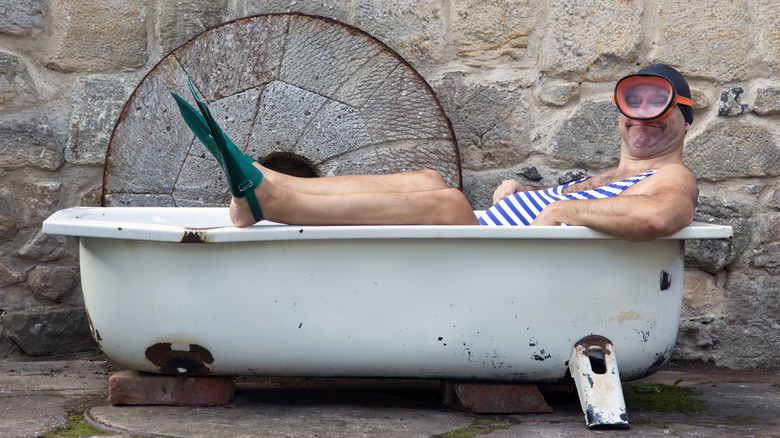Unusual Trends That Only Exist In Europe
We may receive a commission on purchases made from links.
Europe isn't just a different continent, in some ways it's a whole other world — chock full of unusual trends we may have never even heard of over here across the pond. The differences go far beyond language and culture — many European customs and fashions are completely foreign to those of us living elsewhere. Some are downright mystifying, while there are also so trends we wouldn't mind adopting — hygge anyone?
While every country has their own unique trends, Europe is home to some truly unique fads and traditions. From "kidnapping" the bride and groom and slathering them in goop and feathers, to cheese and bathtub races, we may never truly understand these traditions. How many of these popular European trends would you try for yourself?
Slather the bride and groom in sticky substances, then cover them in feathers
Once a nearly forgotten tradition, bridal blackening is now making a surprising comeback in Scotland. According to The Herald in Scotland, the local tradition consists of the bride and groom being "kidnapped" by their friends and covered in substances such as flour, custard, or soot after which they are covered in feathers. This blackening is thought to bring good luck to the couple. The ritual can sometimes get a bit rough, with the happy (and messy) couple being bound as they are blackened. Hopefully no wedding dresses are ruined in the process.
The Swedish death cleaning ritual is actually really thoughtful
It might sound just a little bit morbid, but the attitude behind Swedish death cleaning is actually really practical. In order to offset the burden of having loved ones go through a deceased person's belongings, older Swedes practice "death cleaning." The tradition is typically carried out in a person's later years, although not necessarily when they are expecting to die soon. By getting rid of non-essential items, they minimize clutter and also the burden on their friends and family after they pass away.
The trend has yet to take off in the United States, although that may soon change. Octogenarian Margareta Magnusson is trying to spread the idea of "dostadning" (a combination of the Swedish words for death and cleaning) in her book The Gentle Art of Swedish Death Cleaning. While death cleaning is traditionally practiced by older people, Magnusson told the Washington Post that the practice is "freeing at any age."
Norwegian kids party hard for a month straight like it's their job
In the United States, parties for high school graduates are pretty standard fare. Norway, however, takes graduation celebrations to a whole new level with a tradition called "russefeiring." These blowouts last for an entire month, and graduating students consume more than their fair share of alcohol. "In the American movies, we get the impression that they are so crazy," Fredrik Helgesen, a student leader of his school's russefeiring committee, told the Associated Press. "But we have the craziest celebrations here in Norway. I don't think anything in the world is like this."
Partying for an entire month takes its toll. Drunken injuries are common, though most aren't too serious. The older generations do not fully approve of the partying, but the tradition — which goes back to 1905 — is tolerated. "I would say you only do this one time," said russefeiring participant Eyoub Yemane. "You are only allowed one time, so do it right when you graduate because you never go back here. Never."
This cozy Danish tradition may just be the secret to happiness
Hygge is less of a trend and more of a lifestyle in Nordic countries. "Hygge has been around for centuries," Meik Wiking, author of The Little Book of Hygge, told Time. "It's something I grew up with, and is a central part of Danish culture and DNA. For us, it's not a lifestyle move, it's simply a way of living and how we do things."
This concept might just be the secret to happiness. People in the U.S. trying to adopt the hygge lifestyle need to recognize that it's just that: a lifestyle. While the buzzword has become popular on social media sites to describe all things warm and cozy, hygge is much more than a design aesthetic. Helen Russell, the author of The Year of Living Danishly, described hygge to Time as the "complete absence of anything annoying or emotionally overwhelming." True hygge is prioritizing the relationships and important things in your life.
This intense version of leapfrog involves babies in Spain
Baby jumping is basically the most intense game of leapfrog anyone can ever play. This Spanish tradition has taken place every June for hundreds of years in the village of Castrillo de Murcia. The festival features people dressed as "devils" who are driven out by pious men. It is believed that the "devils" jumping over the babies born in the previous year will ensure that the infants are protected from "disease and misfortune." While it may seem dangerous, there fortunately have been no reports of injuries resulting from the baby jumping.
Despite the absence of injuries, many want to see the religious festival ended. According to Metro UK, Pope Benedict XVI even advised priests in Spain to distance themselves from the practice. In spite of opposition, though, it doesn't look like this centuries-old practice is stopping any time soon.
For a cheesy tradition, it's also pretty dangerous
Every year in Gloucestershire, England, people participate in the annual cheese-rolling race. The contestants chase a Double Gloucester cheese down the steep incline of Cooper's Hill, risking injury as they tumble after it. The tradition dates back to at least the 19th century, though according to the BBC, the practice could date back to ancient times.
The official event was cancelled in 2009 as it was drawing thousands of contestants and spectators, leading to concerns over safety. Cheese-rolling has proven to be too popular to stop, though, and unofficial races continue to be held by the locals. The tradition might be beloved in Gloucestershire, but other areas of the country seem to be reluctant to hurl themselves down a steep hill just to win a wheel of cheese.
Literally get a sparkle in your eye
If you've ever wanted a little more sparkle in your eye, this is one way of doing it. The procedure, devised in the Netherlands, implants jewelry in the eye. The entire thing sounds incredibly uncomfortable, but these extraocular implants reportedly have no adverse side effects. The procedure is mostly done in Europe, although there is at least one U.S. doctor who has performed it — even though, according to ABC News, it isn't approved by the Food and Drug Administration.
There's little chance that the trend will take off in the U.S., as the American Academy of Ophthalmology has urged people not to have the procedure done, warning of "complications including blindness from ocular infection or bleeding, bleeding beneath the conjunctiva, perforation of the eye and conjunctivitis." Illinois approved legislation to make the procedure illegal back in 2005.
Norwegians intentionally bore themselves to sleep
Norway might not have the monopoly on falling asleep while binge-watching a show on Netflix, but they have certainly perfected the art. A recent fad in the country is watching boring television shows. The genre, called "slow TV," features the visual equivalent of background music.
Viewers most likely aren't sitting riveted in front of their screens to several hours of footage of wood burning or people knitting, but they are tuning in when they want something playing in the background that won't consume all their attention. The genre has even made the jump to Netflix so that international audiences can experience this trend for themselves — if they can stay awake. Some of the Norwegian "slow TV" shows that can be found on Netflix include Train Ride Bergen to Oslo and National Firewood Night.
Two words: Bathtub regatta
This unique race is found in Belgium and has an unusual history. According to the BBC, it started in 1982 when Alberto Serpagli found 40 abandoned bathtubs. The tubs were sold at a local market and their buyers transformed the abandoned tubs into makeshift vessels. The first bathtub regatta, known in Belgium as Régate de Baignoires, was held that year with the self-propelled bathtubs racing down the Meuse. The event proved to be a hit and has been held every year since. Who knew your bathtub could also be used as a boat?

